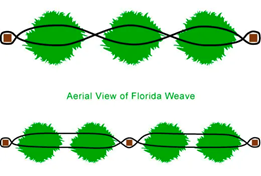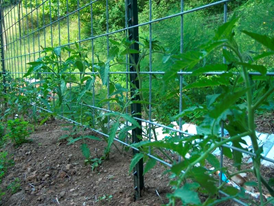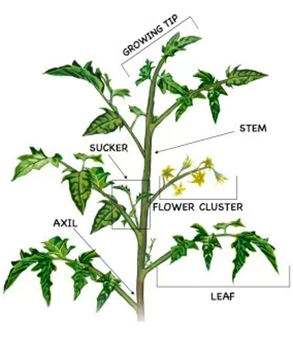All About Trellising (tomatoes and cucumbers):
Many crops have the potential for robust vertical growth when supported by a trellising system. Any viney crop can be transitioned from sprawling ground cover to a single vertical row through trellising. At Hidden Creek Farm, we trellis our tomatoes, cucumbers, and sugar snap peas.
Tomato Varieties: Determinate vs. Indeterminate
- Determinate
- ripen early and in distinguishable flushes
- ideal for canning a lot at once
- 3-4’ tall, “bush” tomato plants
- less to no pruning and trellising required
- stop shoot production once flowers form on shoot ends
- smaller, more appropriate for container growing
- ripen early and in distinguishable flushes
- Indeterminate
- longer growth period, can produce consistent fruit until frost arrives
- 6-20’ tall
- form flowers along sides of shoot and continue to grow
- benefit from pruning and trellising
- most heirloom varieties are indeterminate
Benefits of Trellising:
- Save Space
- Protect plants from physical damage
- More control over moisture/watering
- Increased air flow
- Decreased disease
- Ease of harvest
Preparing to Trellis
- Set up your stakes
- Choose strong wood or metal stakes that are 5-7ft tall
- Space your stakes to allow 2-4 plants (tomatoes/cucumbers) between each stake
- Pound stakes 8in – 1ft into the ground using a post pounder or mallet
- Choose a trellising material
- Twine
- Polypropylene or nylon cording (doesn’t stretch like cotton or hemp)
- Added periodically as the plants grow
- Metal
- Hog wire/woven wire panels in 4 inch square grids.
- Easiest to roll out and attach to stakes before plants are in the ground.
- Attach ~2ft above the ground.
- Twine
Trellising
- Begin trellising when plants are about 2ft tall, or start to bend
- Twine
- Wrap twine end around 1st stake twice and tie securely
- Weave twine between tomato plants and around each stake. Sandwich plants between twine with the same weave on the way back (Florida Weave). Tie securely on final stake.
- Keep twine taught to ensure adequate support
- Repeat every 6in-1ft as the plant grows
- Twine

- Metal
- Weave plants through grid or use twine to attach vines to metal
- Weave plants carefully to avoid snapping stems. Keep ties loose to allow the vine to increase width as the plant grows.
- Repeat every 6in-1ft as the plant grows
- Beans and peas will attach to the trellising material on their own. They should not need to be tied but may occasionally need to be redirected towards the trellis.

Pruning (tomatoes)
Choosing one or two “leaders”.
Most tomatoes have indeterminate growth, meaning they will continue growing as much as nutrients and the season will allow. Tomatoes start with one growth point at the top of the main stem and will continue to produce new growth points, called “suckers”, as they grow. “Suckers” are new growth points that form in the “axil” where leaf stems attach to the main growth stem.
Choosing one leader, means keeping the main stem as the only growth point and pruning off all other growth points. Choosing two leaders means keeping the main stem and keeping one sucker near the base of the plant that will develop into a second main stem. Plants spaced 1ft apart should have one leader. Plants spaced 2ft apart can be pruned either way. At Hidden Creek Farm we have found the two leader method to produce the most fruit per plant and per bed foot.
- Remove any flowers at time of planting, so energy goes into leaf growth instead of fruiting (that the plant can’t support!) at this early stage
- As the plant grows, remove all leaves and suckers below the first fruit cluster (except sucker selected as the second lead) .
- Try to remove the suckers when they are small to avoid leaving large wounds on the stem.
- Pruning above the first fruit cluster depends on how close the plants are spaced and how leafy the varieties are.
- More pruning increases airflow which helps limit moisture and disease
- Too much pruning decreases shading on the fruits and can lead to “sun scald”; yellow or gray spots with a papery surface.
- One compromise is to allow suckers to develop one set of leaves before snipping off only the growth point. This keeps leaves for shade without extra vines.

Limiting disease when pruning
- Only prune when plants are dry. Most tomato disease transfers through water. Moving moisture that accumulates on clothes and hands as you prune will quickly spread disease.
- Prune with sharp scissors or a knife to avoid tearing tissue and creating larger wounds. Wounds are entrance points for disease.
- Clean tools thoroughly before using. Dirty tools can easily spread disease between plants.

